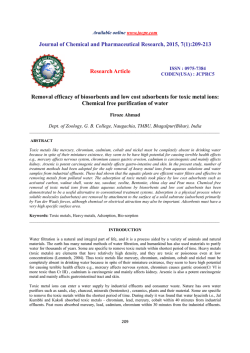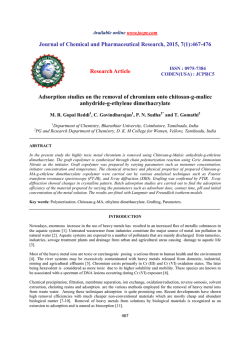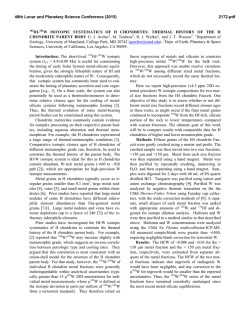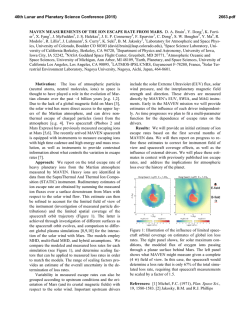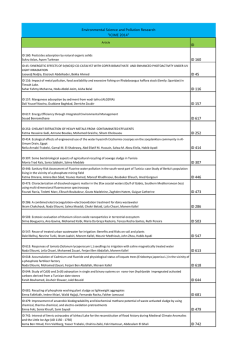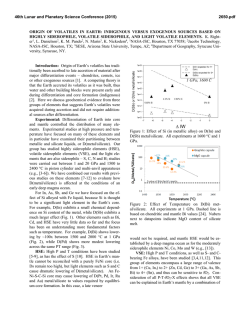
And Zn(II) - Journal of Chemical and Pharmaceutical Research
Available online www.jocpr.com Journal of Chemical and Pharmaceutical Research, 2015, 7(1):546-555 Research Article ISSN : 0975-7384 CODEN(USA) : JCPRC5 Biosorption of Pb(II) And Zn(II) from aqueous solutionusing langsat (Lansium domesticum Corr) fruit peel Khoiriah, Firda Furqoni, Rahmiana Zein and Edison Munaf* Laboratory of Analytical Environmental Chemistry, Faculty of Mathematics and Natural Sciences, Andalas University, Padang, Indonesia _____________________________________________________________________________________________ ABSTRACT This study eximines the possibility of using Lansium domesticumCorr peel in removing Pb(II) and Zn(II) from aqueous solution. It had been found that the biosorption capacities were significantly affected by solution pH, contact time, initial metal inon concentration, biosorben dose, and temperature of biosorbent. The maximum uptake of Pb(II) and Zn(II) was 9.6804 mg/g and 8.754 mg/g respectively from 20-350 mg/L of metal solution at pH 5 by using 0.5 g lansium domesticum corr. The Langmuir and freundlich adsorption models were used to represent the experimental data and equilibriuem data. The metal removal rates were rapid , with 90% of the total adsorption taking place within 8 min for Pb(II) and 4 min for Zn(II) Langsatpeel showed the highest potential for removing of toxic metal from aqueous solution. Keyword : Biosorption, Lansium domesticum Corr peel, Isotherm adsorption, Freundlich, Langmuir . _____________________________________________________________________________________________ INTRODUCTION Pollution of water with toxic substances is the most concern for human health as well as for theenvironmental quality. According to the World Health Organization (WHO), the metals of most immediate concern are aluminum, chromium, manganese, iron, cobalt, nickel, copper, zinc, cadmium, mercury and lead [1]. They are released from industrial activities such as, paints, pigments, batteries, ceramic glazes, metal products and ammunition production.Due to their toxicity and non-biodegradability they can accumulate in food chain posing a severe damage to the living organisms[2]. Therefore, different methods for the removal of these metals from aqueous solution such as chemical precipitation, ion exchange, filtration, membrane separation, adsorption and reverse osmosis have been reported. These methods are either expensive or inefficient, especially when the concentrations of heavy metal ions are less than 10 mg/L [3].The search for new, effective and economical technologies involving the removal of toxic metals from wastewaters has directed attention to biosorption based on metal binding capacities of various biological materials at little or no cost. Biosorption techniques for wastewater treatment have become more popular in recent years with regard to their efficiency in the removal of pollutants, especially heavy metal ions[4].Adsorbent generated from these biomass are cost effective and effecient. Several agricultural waste materials have been studied and developed for the effective removal of heavy metals like banana peel[5], rice straw [6], Alpinia galanga Willd [7], orange peel [8], modified rice bran [9], Rubber Tree Leaves [10], and Peganum harmala seeds [11].Langsat is a genus of small trees from the family Meliaceae that found wild and cultivated in Indonesia and surrounding countries in the region (Thailand, Vietnam, Philippines and Malaysia) as it is known a common fruit tree in South-East Asia. The peel contains large quantities of secoonoceranoids such as lansic acid (major component) and lansiolic acid (minor)[12]. Most of the langsatpeel has been thrown as waste. The aim of the present study is to examine the ability of Lansium domesticum corr peel as a cheep biosorbent for removal of Pb(II) and Zn(II) ions from aqueous solutions. The adsorption equilibrium was determined. Langmuir and Feundlich isotherm equations were employed to quantify the adsorption equilibrium. The 546 Edison Munaf et al J. Chem. Pharm. Res., 2015, 7(1):546-555 ______________________________________________________________________________ effects of solution pH, adsorbent dose, ion metals concentration and contact time and adsorbent temperature on Pb(II), Zn(II) adsorption were examined. EXPEIMENTAL SECTION Treatment of Langsat peels Langsat peels, a by-product of langsat (Lansium domesticum) peel was collected from the local market of West Sumatera Province, Indonesia. The Langsat peels were washed several times with water to remove all the dirt particles and this was followed by sun-dried. Dried langsat peels was cuted, ground and sieved through a mesh filter to give particles of ≤125 µm. The powder then collected in a bottle for using as as a adsorbent. Chemical and apparatus All reagents were used of analytical grade obtained from Merck (Darmstad, Germany). The apparatus were used screener Octagon 200 (Endcots, London, England), an analytical balance (AA-200 Denver Instrument Company), a shaker (Haake SWB 20), a pH meter (Denver Instrument Company), FTIR( Bio-Rad FTS 60), atomic absorption spectrometer (AAS Alpha-4, Analys 100, London, England), and SEM (Hitachi SU 3500). Pb(II) and Zn(II) working standard solution was prepared from 1000 mg/L stock standard solution. Batch biosorption studies Dried langsat peels were soaked with 0.1 mol/L nitric acid for 2 hours, and then were filtered and finally washed until neutral by using distilled water before drying at room temperature. A stock standard solution of Pb(II) and Zn(II) with concentration 1000 mg/L each was prepared and suitably diluted the required initial concentrations. Adsorption experiments were carried out at various temperature, pH solution, contact time, adsorbent dose, and initial concentration (Ci) under batch mode. The pH of the solutions was adjusted to the required value (range 2-8) by adding dilute solution of HNO3 and NaOH in a 50 mL Flask. Then, the flasks were placed on a rotating shaker with constant shaking, and at the end of experiment, the flasks were removed from the shaker and solution were separated from biomass by using filter paper. The final concentrations (Cf) were measured by atomic absorption spectrophotometric method (AAS). The metal ion uptake capacity of the biosorbent (qt, mg/g) was calculated from Equation. Q= RESULTS FTIR analysis The spectrum for Langsat peels before adsorption (Fig.2a) demonstrates distinct peak at 3423.02 cm-1 representating O-H bond in alcohol, peak at 2918.85 cm-1 representing C-H streching, peak at 1711.03 cm-1 representing C=O in carbocylic group, peak at 1648.07 cm-1 representing N-H, peak at 1038.22 cm-1represnting C-O in alcohol.Several shifts of peak were observed after adsorption (Fig. 2b) peak at 3423.02 cm-1 shifted to 3412.53 cm-1,peak at 2918.85 cm-1 shifted to 2937.11 cm-1, peak at 1711.03 cm-1 shifted to 1709.28 cm-1,peak at 1648.07cm-1 shifted to 1643.83 cm-1, and peak at 1038.22 cm-1 shifted to 1031.85 cm-1suggesting that metal ion interacts with hydroxyl and carbocylic groups present on the surface of langsat peels.The above studies reveal that the main functional groups present on the surface of the biosorbents involved in the uptake of metal ion are hydroxyl, carbocylic and alcohol groups. SEM analysis The SEM analysis was performed to observe the surface morphology of the biosorbents before and after metal ion adsorption. The SEM image in (fig.3a)2000 X magnification shows that langsat has hollow for langsat before interaction with metal species.But after contacting with metal ion the hollow of langsat peel bacomes filled in (fig.3b). So, SEM analysis revealed that there were significant changes on the surface of biosorbents after interaction with metal ions. Effect of pH solutionon metal ion uptake The pH of the solution has significant effect on adsorption process as it influences the charge on the surface of adsorbents and metal ion speciation in aqueous solution. The studies of effect of solution pH werecarried out in the pH range of 2 to 8. Figure 4shows the optimum pH for adsorption of Pb(II) and Zn(II) was recorded at pH 5 onto langsat peel. From that figure, by increasing the solution pH from 2.0 to 5.0 has increasedthe amount of Pb(II) and Zn(II) uptake. This observation can be explained by the fact that the concentration of H3O+ ion was high at low pH. This scenario will cause competition between H3O+ and metal ions for active sites on the surface of biosorbents [1317]. As the solution pH increased the concentration of H3O+ ion in the solution decreased, lowering the competition 547 Edison Munaf et al J. Chem. Pharm. Res., 2015, 7(1):546-555 ______________________________________________________________________________ of metal ion for active sites.But the removal of both ions were found decreasing at pH 6.0 unti 8.0 cause of the deprotonation of functional groups is expected to rise, thus strengthening the attraction between the negative charge on biosorbent surface and the positive metal ion above the optimum pH, a decreased in metal ion uptake may be due to the complexation of Zn(II) and Pb(II)with OH- [7] in the aqueous solution, thus precipitation of metal ion occurs. Vanidainvestgated the adsorption of lead (II) and Zinc (II) ions onto Alpinia galanga Wild, R.Zein[18] investigated the removal of lead (II) and zinc (II) using Garcinia mangostana L. sheell, Mohammad [19] investigated the adsorption of lead, zinc and cadmium ions onpolyphosphate-modified kaolinite clay, Yussoff[13] examined the removal of Cu(II), Pb(II) and Zn(II) Ionsfrom aqueous solutions using selectedagricultural wasteswho also got the optimal pH for adsorption as 5. Fig 1.(a)Lansium domesticum Corr Figure 1.(b) dried Lansium domesticum Corrpeel Fig 1. (c) Lansium domesticum Corrpeel powder Effect of contact time on metal ion uptake The biosorption capacity of metal ions was evaluated as a function of contact time. The initial concentration of metals was 20 mg/L. The metal uptake was rapid for both ions at the beginning of the biosorption process and gradually decreased as time progressed to attain equilibrium after 4 and 8 min for Zn(II) and Pb(II), respectively (Fig. 5). The metal uptake capacity of biomass at 20 mg/L metal solution was different for two metals. The highest metal uptake obtained for Pb(II) and Zn(II) were 0.75976 mg/g and 0.68014 mg/g and respectively on dried biomass. Effect of initial concentration on metal ion uptake Figure 6 showed the heavy metal ion biosorption capacities of langsatpeels as a function of the initial concentration of Pb(II) and Zn(II) ion within the aqueous solution. The amount of metal ions adsorbed per unit mass of peels increased with an increased in initial metal ion concentrations and then decreased. This increased could be due to the increased in electrostatic interactions (related to covalent interactions) [20, 21] involving sites of progressively lower affinity for metal ions. Therefore, more metals ions were left un-adsorbed in solution at higher concentration levels. The optimum Pb(II) is 9.6804 mg/g at initial concentration 250 mg/L. R.Zein [18] investigated the biosorption of lead (II) ions on Garcinia mangostana Lalso got the optimal removal of Pb(II) at 250 mg/L. Effect of adsorbent dose on metal ion uptake An increase in biosorbent concentration generally increases the adsorbed metal ion concentration because of larger adsorption surface area. However, further increase in biomass dose decreases the metal specific uptakes.Varying the 548 Edison Munaf et al J. Chem. Pharm. Res., 2015, 7(1):546-555 ______________________________________________________________________________ dosage of langsat peels powder within the range 0.5-1.5 g indicated that optimal adsorption of metal ions on 0.5 g langsat peels, a dosage at which sufficient binding sites were available to adsorb the maximum metal ions for both of Pb(II) and Zn(II). However, as the mass of langsat peels increased above 0.5 g, a steady decrease in the mass of metal adsorbed was recorded (Fig.7). These results agree with those of Vanida[7], Kazemipour [22]Anwar [23], Marandi [20], Witek-Krowiak [24], and Desirreddy [25] which indicate that at high adsorbent dose partial aggregation of the adsorbent occurs, decreasing the availability of active binding sites and causing a decrease of the effective adsorption area. 1711.03 a 3423.02 1038.22 2918.85 1709.28 b 3412.5 1648.07 1643.83 1031.85 2937.11 Fig 2. FTIR spectra of langsat peel (a) before and (b) after adsorption Fig 3.(a)SEM of langsat peel before (b) afteradsorption 2000 X 549 Edison Munaf et al J. Chem. Pharm. Res., 2015, 7(1):546-555 ______________________________________________________________________________ 1 Q (mg/g) 0.75 0.5 0.25 0 0 1 2 3 4 5 6 7 8 9 pH of solution Fig4.Effect of pH solution on the uptake of Pb(II) and Zn(II), metal ions solution = 20 mL, concentration of solution = 20 mg/L, biomass dose = 0.5 g Q (mg/g) 1 0.8 0.6 0.4 0.2 0 1 2 3 4 5 6 7 8 9 10 11 Contact time (min) Fig 5..Effect of contact time on the uptake of Pb(II) and Zn(II), metal ions solution = 20 mL, concentration of solution = 20 mg/L, biomass dose = 0.5 g, at pH=5 Effect of adsorbent temperature on metal ion uptake Temperature is one of major factor which effects amount of ion metal uptake. Figure 8 shows that with increasing adsorbent temperature from 27̊C to 160̊C, the metal ion uptake decreases. This observation can be explained by the fact that the adsorbent is used contining organic compounds. As the high heat of adsorbent, the functional groups in adsorbentbecome demaged. Desorption Desorption corresponds to remove the metal from the binding site of adsorbent surface and then it is expected that the H+ ions can replace cations adsorbed by ion exchange machanism. In this experiment (fig.9), the maximum percentage of ion metals desorption are 97% for ion Pb(II) and 86.6332% for in Zn(II) by HNO3 at pH 1, thus 550 Edison Munaf et al J. Chem. Pharm. Res., 2015, 7(1):546-555 ______________________________________________________________________________ indicating that at pH 1, amount of H+ are greater than other pH (2 and 3). The greater amount of H+, the greater amount of ion metal desorbed. Q (mg/g) 10 8 6 4 2 0 0 100 200 300 Initial concentration (mg/L) Fig 6. Effect of initial concentration on the uptake of Pb(II) and Zn(II), metal ions solution = 20 mL, concentration of solution = 20-350 mg/L, biomass dose = 0.5 g, at pH=5, and contact time 8 min for Pb(II) and 4 min for Zn(II) Q (mg/g) 10 8 6 4 2 0 0 0.5 1 1.5 Adsorbent dose (g) Fig 7.Effect of adsorbent dose on on the uptake of Pb(II) and Zn(II), metal ions solution = 20 mL, concentration of solution = 250 mg/L for Pb(II) and 300 mg/L for Zn(II), biomass dose = 0.5 g, at pH = 5, and contact time 8 min for Pb(II) and 4 min for Zn(II) Adsorption Isotherm Adsorption isotherm models have been used to describe the interaction between metal ion in solution and adsorbents[26-28]. In addition, the isotherm models can be used to explain the distribution of metal ion between the liquid and solid phase when equilibrium was reached [28-30]. The most widely used isothermmodels are Freundlich and Langmuir models. Freundlich isotherm model deals with adsorption at multilayer heterogeneous surface[31]. According toFreundlich isotherm model, during adsorption process stronger binding sites will occupy first [32]. As more sites occupied by metal ion, the binding strength becomes weaker28.The Freundlich linear form is given by the following equation. Log qe = log KF + 1/n log Ce 551 Edison Munaf et al J. Chem. Pharm. Res., 2015, 7(1):546-555 ______________________________________________________________________________ 10 Q (mg/g) 8 6 4 2 30 60 90 120 150 Adsorbent temperature (C) Fig 8. Effect of adsorbent temperature on the uptake of Pb(II) and Zn(II), metal ions solution = 20 mL, concentration of solution = 250 mg/L for Pb(II) and 300 mg/L for Zn(II), biomass dose = 0.5 g, at pH = 5, and contact time 8 min for Pb(II) and 4 min for Zn(II) % Regeneration 100 80 60 40 20 0 0 1 2 3 4 pH of HNO3 Fig 9.Effect of pH HNO3 on ion metal regeneration Where KF is a constant related to the adsorption capacity (Freundlich constant) and 1/n is an empirical parameterrelated to the adsorption intensity (which varies with the heterogenity of the material). Values of 1/n and KF arecalculated respectively from the slope and the intercept of plot of log qe vs log Ce, is shown in figure 10. The Langmuir isotherm model assumes all sites on adsorbents have equal energy [33-34]. During adsorption process, metal ion forms a monolayer on the adsorbent surface and when all sites are occupied, there will be no more binding can take place [28,30]. Furthermore, the favorability of adsorption was tested using a dimensionless constant called separation factor (RL) which is an essential feature of the Langmuir isotherm: 1 1 + Kl. Co 552 Edison Munaf et al J. Chem. Pharm. Res., 2015, 7(1):546-555 ______________________________________________________________________________ = . + where Qm was the maximum metal uptake corresponding tothe saturation capacity (mg/g), KL was energy of adsorption(L/mg), Qe was the amount of metal adsorbed on the biomass(mg/g) and Ce was equilibrium metal concentration in solution(mg/L) and Co was initial concentration of ion metal. R2 = 0.7570 Log Qe 1 0.5 R2= 0.9689 0 0 1 2 log Ce Fig 10. Linearized Freundlich equation for Pb(II) and Zn(II) 10 R2 = 0.9419 Ce/Qe 8 R2 = 0.9832 6 4 2 0 0 20 40 60 80 Ce (mg/L) Fig 11. Linearized Langmuir equation for Pb(II) and Zn(II) Tabel 1lists the calculated Freundlich and Langmuir isotherm constants. From Table1, for Pb(II) adsorption onto langsat peel, the adsorption data fit the Langmuir isotherm modelbetter Freundlich by a higher value for the regression coefficient R2 is 0.9832. The maximum adsorption capacities (Qm) estimated from the Langmuir isotherm model for Pb(II) is 9.19286 mg/g.Based on the RL values, the adsorption process iscategorizedas unfavorable(>1), linear (=1), favorable (0<RL<1) and irreversible(=0). Thus, the proposed method can be considered as afavorable uptake process for the studied metal ions (Table 1). 553 Edison Munaf et al J. Chem. Pharm. Res., 2015, 7(1):546-555 ______________________________________________________________________________ The adsorption of Zn (II) onto langsat peel was best described by the Freundlich isothermmodel bacause of a higher value for the regression coefficient R2 is 0.9689. The value of n is 2.2962, this indicating that the adsorption condition for Zn(II) onto langsat peel is favorable because the intensity constan value (n) > 1. Tabel 1.Langmuir and Freundlich parameters Ion metal Pb Zn KL 0.1335 0.0365 Langmuir Qm(mg/g) 9.19286 7.8125 R2 0.9832 0.9419 Rl 0.2725 0.5780 Kf 1.3505 0.7979 Freundlich n R2 1.8054 0.7570 2.2962 0.9689 CONCLUSION FTIR spectra of langsat peel revealed the presence of O-H, C-H, C=O, N-H and C-O streching in the adsorbent. These groups were responsible in metal ion uptake process since there was some shift of those peaks. The result of these studies indicated that the capacity biosorption of Pb(II) and Zn(II) ions by langsat peel (Lansium domesticum Corr) were effected by pH solution, contact time, initial metal ion concentration, biomassa dose, and adsorbent temperature. The optimum pH in Pb(II) and Zn(II) uptake was found to be at pH 5, for both of metal ions. Amount of Pb(II) and Zn(II) uptake increased with increasing contact time and equilibrium were attained in 4 min and 8 min, respectly. The biosorption capacity decreased as the biomassa dose and temperature of adsorbent increased. The Langmuir model is well discribed for ion Pb(II) uptake by langsat peel. While for ion Zn(II) is better in Freundlich model. Desorption percentage of metal ions from langsat peels are greatest with HNO3 at pH 1. The percentageare 97% for ion Pb(II) and 86.6332% for ion Zn(II). REFERENCES [1] GO El-Sayed, HA Dessouki, SS. Malay. J.Analyt.Sci.,2011, 15( 1), 8 – 21. [2] D Tirumalaraju, SMishra. IJESD,2011, 2(4), 285-293. [3] MW Amer, FI Khalili, AM Awwad. J.Environ.Chem and Ecotoxicol,2010, 2(1), 001-008. [4] MT Osobamiro, OO Adewuyi.Continent.J. Enviro.Sci.2012,6 (3), 1 – 7. [5] SDR Castro, L Caetano, GFerreira, MPPedro, JS Margarida, FZLuiz, AUM Marco, RC Gustavano. Ind. Eng. Chem. Res.2012,50, 3446–3451. [6] W.M.Mousa, S.I Soliman, A.B.El-Bialy and A.S.Hanaa. J.Appl.Sci.Res. 2013, 9(3), 1696-1701. [7] VChairgulprasert, AJapakeya, H Samaae.Songklanakarin. J.Sci. Technol. 2013, 35(2), 227-233. [8] E Bernard, A.Jimoh.Int.J.Engand Appl.Sci. 2013, 4(2). [9]T Fatima, R Nadeem, AMasood, RSeed, MAshraf. Int. J. Environ.Sci Technol. 2013, 10, 1255–1264. [10] UHaq, B Irshad, E Nursafura, KZakia.Int. Res. J. Environ. Sci.2013,2(12), 2319–1414. [11] AAZamani, R Shokri, MR Yaftian, AH Parizanganeh.Int. J. Environ. Sci. Technol. 2013,10, 93–102. [12] MNishizawa, MEmura, HYamada, MShiro, Chairul, YHayashi, Harukuni, Tetrahedron Lett.1989, 30, 56155618. [13] Yusoff, SN Mohd, A Kamari, WP Putra, CF Ishak,A Mohamed, N Hashim, IM Isa. J. Environ. Protection. 2014, 5, 289-300. [14] DHK Reddy, KSeshaiah, AVR.Reddy, MM Rao,MC Wang.J. Hazard. Mater. 2010,174, 831-838. [15] H Benaїssa, MA Elouchdi. Chem. Eng and Processing. 2007,46, 614-622. [16] HDDoan, ALohi, VBH Dang, T Dang-Vu, Process Safety.Environ.Protect. 2008, 86, 259-267. [17] YLiu, QCao, FLuo, J Chen.J.Hazard.Mater. 2009, 163, 931-938. [18] RZein, R Suhaili, F Earnestly, Indrawati, E Munaf. J.Hazard.Mater.2010,181, 52-56. [19] Amer, WMuhammad,IKFawwaz, AM.Awwad. J.Environ. Chem. Ecotoxocol. 2010,2(1), 001-008. [20] RMarandi, FD Ardejani, HA Afshar. Int.J.Mining & Environ.2010,1(1). [21] MIKurniawan, ZAbdullah, A Rahmadani, RZein, E Munaf. Asian. J.Chem. 2014,26(12),3588-3594. [22] MKazemipour, MAnsari, STajrobehkar, M Majdzadeh, HR Kermani. J.Hazard. Mater. 2008,150, 322-327. [23] JAnwar, UShafique, WZaman, MSalman, A Dar, SAnwar.Bioresource Technol.2010,10, 1752-1755. [24] AWitek-Krowiak,RGSzafran, S.Modelski.Desalination. 2011, 265, 126–134. [25] DHKReddy, L Seung-Mok, K Seshaiah.Water Air Soil poll.2011,223, 5967-5982. [26] RKaur, JSingh, RKhare, SS Cameotra, A Ali.Appl.Water Sci. 2013, 3, 207-218. [27] YLiu, QCao, F Luo, J Chen.J. Hazard. Mater. 2009,163, 931-938. [28] UJEtim,SA Umoren, UM Eduok.J.Saudi Chem. Soc.2012 [29] WSW Ngah, S Fatinathan. J. Enviro.Manage. 2010,91,958-969. [30] MKSureshkumar, DDas, MB Mallia, PCGupta.J.Materials. 2010, 184, 65-72. [31] AHeidari, HYounesi, Z Mehraban, HHeikkinen.Int.J. Biol.Macromol. 2013,61, 251-263. 554 Edison Munaf et al J. Chem. Pharm. Res., 2015, 7(1):546-555 ______________________________________________________________________________ [32] IAW Tan, AL Ahmad, BH Hameed.J.Hazard.Mater. 2009,164, 473-482. [33] JSKwon, ST Yun, JHLee, SOKim, HY Jo.J.Hazard. Mater. 2010,174, 307-313. [34] SLiang, X Guo, QTian.Desalination. 2011, 275, 212-216. 555
© Copyright 2025
